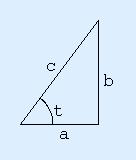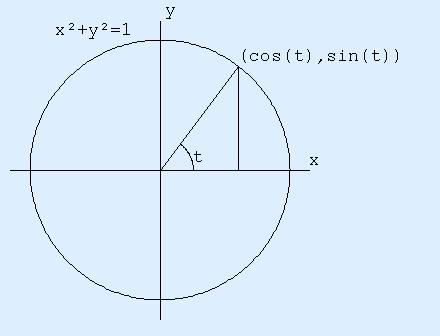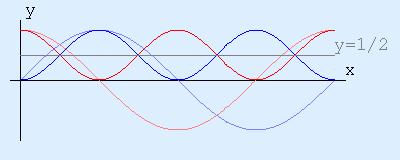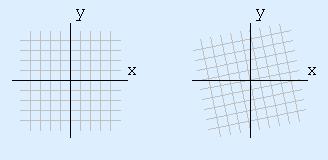Cos Squared Plus Sine Squared
Different means of viewing cos2(t) + sin2(t) = 1
by Walter Vannini
Triangles
Unit Circle
Root Mean Square
Rotation Matrix
Determinant
Orthonormal Footing
Combinatorial Identities
Exponential Function
Algebra
Factorization
Parametrized Curve Derivatives
Integral
Conservation Of Energy
Hyperbolic Analogues
Feedback
Introduction
Nosotros will explore various interpretations of the above identity. Later parts of this essay don't often depend on earlier parts, so please feel gratis to skim by incomprehensible text until you find something y'all're comfy with.
Triangles
The usual way the identity is understood is via Pythagoras' theorem. In a right angled triangle with sides a,b,c, and angle t at the vertex where a and c meet, cos(t) is by definition a/c, sin(t) is by definition b/c , and so cos2(t) + sin2(t) is (a/c)2+(b/c)two , which by uncomplicated algebraic manipulation is (atwo+bii)/cii . Pythagoras' theorem states that a2+b2 is ctwo , and and then this simplifies to 1.

Unit Circle
Traditionally (ie. the fashion I learned information technology), the side by side footstep is to realize that the unit circumvolve centered at (0,0) in the (10,y) airplane is defined by ten2+yii=1. The in a higher place identity tin then exist interpreted as maxim that the point (cos(t), sin(t)) is on the unit circumvolve. Furthermore, this approach leads to a definition of cos(t) and sin(t) for all real t.

Root Mean Foursquare
Another manner to understand this identity is via the trigonometric identities
| cos2(x) | = | i/2 | + | (1/2) | cos(2x) | |
| sin2(x) | = | one/2 | - | (i/2) | cos(2x) |
Incidentally, these identities pretty much leap out at you lot from looking at the graphs of y = costwo(10) and y = sin2(10).

Another way to look at information technology is to retrieve that the root mean square of cos is 1/√2, as is the root mean square of sin. This means that cos2 is 1/2 + variation, and sin2 is 1/two + variation, and amazingly the variation of cos2 is precisely the negative of the variation of sin2 . Actually, this does fit in with the fact that sin and cos are but phase-shifted versions of each other, and so that sin2 and cos2 are phase-shifted versions of each other, and so their variations should be somehow related.
Anyway, nosotros now have that cos2(t)+sinii(t) is of the course (ane/two + deviation) + (one/2 - deviation), and so this is 1.
Rotation Matrix
Yet another manner to empathise the identity is via ii by 2 matrices. The linear matrix that represents an anticlockwise rotation past angle t is
| cos(t) | -sin(t) |
| sin(t) | cos(t) |

Determinant
The matrix
has determinant ad-bc, so the rotation matrix has determinant cos(t)cos(t)-(-sin(t))sin(t), which is cos(t)cos(t)+sin(t)sin(t) , ie costwo(t)+sintwo(t). The determinant of a foursquare matrix has a uncomplicated geometric interpretation. Information technology is the area scaling factor. For a rotation, expanse is unchanged, and then the determinant has to be i. Then the identity cos2(t)+sin2 (t)=ane can be interpreted as expressing the rather obvious fact that rotating an object in the (x,y) plane does not change its area.
Orthonormal Ground
The rotation matrix sends the point (1,0) to (cos(10),sin(x)) and the point (0,ane) to (-sin(ten), cos(ten)). The standard basis eastward1=(1,0), etwo=(0,i) is an orthonormal basis, pregnant that
eane.due eastone=1 (check: 1.one+0.0=ane)
e1.e2=0 (bank check: 0.1+1.0=0)
e2.e2=1 (check: 0.0+1.one=ane)
Since a rotation is a "rigid motility", it will transform an orthonormal basis to another orthonormal basis. This ways that the to a higher place 3 equations will be truthful when e1 is (cos(t), sin(t)), and eastward2 is (-sin(t), cos(t)). The two equations e1.e1 = 1 and east2.eii = 1 are each a restatement of cos2(t) + sinii(t) = 1, while ei.e2 = 0 is a statement of the identity cos(t)(-sin(t))+sin(t)cos(t) = 0. Strangely enough, even the east1.e2 statement is a manifestation of the identity, as is shown below.
Combinatorial Identities
Another way to look at the identity is via the ability series expansions of cos(ten) and sin(x).
| cos(x) | = | ane | - | xtwo/2! | + | x4/iv! | - | xhalf-dozen/6! | + | ten8/8! | - | … |
| sin(x) | = | x | - | 10three/3! | + | ten5/5! | - | xseven/7! | + | … |
This ways that
| cos2(ten) | = | 1 | - | (ane/ii! + one/ii!) | 102 | + | (i/4! + 1/2!2! + i/4!) | x4/4! | - | … |
| sin2(x) | = | x2 | - | (1/three! + 1/iii!) | xiv/iv! | + | … |
In this context, the identity cosii(t)+sin2(t)=1 is really encoding an space number of identities involving factorials, namely
| 1/2! + one/2! | = | 1 |
| 1/4! + 1/two!ii! + 1/iv! | = | one/3! + 1/iii! |
| 1/six! + 1/4!two! + 1/2!4! + 1/6! | = | 1/5! + 1/3!three! + 1/5! |
| … |
These identities can be reexpressed in terms of combinatorial coefficients ( northwardCr = due north!/(n-r)!r!)
| 2C0 + 2C2 | = | 2C1 |
| 4C0 + fourCtwo + 4Cfour | = | 4Ci + 4C3 |
| 6C0 + 6Ctwo + 6C4 + 6C6 | = | 6C1 + half dozenC3 + sixCv |
| … |
These are maxim that the even combinatorial coefficients sum upwardly to the aforementioned effect as the odd combinatorial coefficients. This result tin be proved directly. Information technology is about easily seen by looking at Pascal'south triangle, and calculation the terms in a row in 2 different ways. Furthermore, using the ability series expansions to extend the definition of cos and sin to the complex numbers, nosotros now know that the identity is true for complex t. Thanks to Bob Uva for pointing this out.
Exponential Office
| Continuing along these lines, the fact that | |||
| e10 | = | 1 + x + 102/2! + x3/3! + x4/iv! + … | |
| immediately tells us that | |||
| eix | = | 1 + ix - 10ii/2! - 9iii/3! + 10four/four! + … | |
| which is, splitting into the even and odd powers | |||
| eix | = | cos(x) + isin(ten) | |
| At this bespeak there are two means to get to the identity. | |||
Algebra
The first is to realize that the single equation e9 = cos(x)+isin(10) gives us the equation e-9 = cos(x)-isin(x) and from these two equations we tin solve for cos(10) and sin(10) to get
cos(ten) = (eix+east-nine)/ii
sin(x) = (enine-e-ix)/2i.
Letting w represent eix , and then that 1/w is e-ix , we have that cos2(x)+sintwo(x) is (west+i/w)2/4 - (due west-1/due west)2/4. This simplifies to one. Then the trigonometric identity can be viewed every bit the algebraic identity (w+1/w)2 - (w-1/w)2 = iv.
Factorization
The second is to exist clever (in a different fashion), and realize we can factorize a2 + b2 as (a-ib)(a+ib). If you haven't seen this before, it'due south a restatement of aii-b2 = (a-b)(a+b). Using complex numbers, we take that -btwo is (ib)2 , which leads to aii+b2 = a2-(-bii) = a2 - (ib)2 = (a-ib)(a+ib). Incidentally, it's of form as well true that a2+b2 = (b-ia)(b+ia). Anyway, applying the factorization to cos2(x)+sinii(ten), we get (cos(ten)+isin(x))(cos(x)-isin(x)), which is eixe-ix . Using w to stand for eix , the fact that cosii(x)+sin2(x)=1 is only a convoluted way of saying w(one/w)=1.
Parametrized Curve Derivatives
Consider the parametrized curve c(t) = (cos(t), sin(t)). The identity tells the states that this parametrized curve is always on the unit of measurement circle well-nigh the origin. Differentiating, nosotros accept c'(t) = (-sin(t), cos(t)) . c'(t).c'(t) is (-sin(t))(-sin(t)) + cos(t)cos(t), which is merely cosii(t)+sin2(t). The fact that this is 1 tells us that the parametrized curve is actually parametrized by arc length. So, the trigonometric identity tin exist viewed every bit just stating the fact that radians traverse the unit circumvolve at unit speed. Finally, differentiating once more, we get c''(t) = (-cos(t), -sin(t)). Apparently, c''(t).c''(t) = cos2(t) + sin2(t), then that the identity tells us that moving uniformly along the circumvolve results in an dispatch of constant magnitude.
Integral
Finally, another arroyo to establishing that cosii(ten)+sintwo(x) is ane is to realize that it is really stating two separate backdrop, namely that cos2(ten)+sin2(x) is a constant, and that the constant happens to be one, ie. for some value of x, cos2(ten)+sin2(10) is ane. The latter property is quickly established: taking x=0, cos(x)=one and sin(10)= 0. Clearly 12+02 =1.
Given a function f, to establish that f is a constant function, information technology suffices to constitute that the derivative of f is zero. Applying this technique to f=cos2+sin2 , the first pace is using the chain rule to go that the derivative of cos2(x)+sin2(10) is 2cos(10)cos'x + 2sin(10)sin'(ten). Via the derivative identities cos'(x) = -sin(ten), and sin'(ten) = cos(10), we have that 2cos(x)cos'x + 2sin(x)sin'(x)simplifies to 2cos(x)(-sin(x)) + 2sin(10)cos(x) , which is zip. So the identity tin can exist viewed as the integrated version of the petty identity
cos(x)(-sin(x)) + sin(x)(cos(x)) = 0, which we saw earlier in a completely different context.
Conservation Of Energy
Yet another mode to see that the cosii+sintwo is constant is to realize that it represents the sum of the potential and kinetic energies of the solution x=cos(t) to the equation for unproblematic harmonic move x''(t)+ten(t)=0.
For a particle of mass ane, the kinetic energy is (1/two)x'(t)ii , and the potential energy is (one/2)10(t)2 (upto an additive abiding). Conservation of free energy tells usa that (1/2)10'(t)2+(1/two)x(t)ii is a constant, and so ten'(t)2+ten(t)two is also a constant. Taking the solution 10(t)=cos(t) (or x(t)=sin(t)) we get the identity.
I should mention that none of the above mathematics is dependent on the underlying physics. If 10(t) is a solution to the second guild equation x''(t)+F(10(t)) = 0, and so (1/2)x'(t)2 + Five(10(t)), where 5 is an antiderivative of F, is constant. Uncomplicated differentiation extablishes this.
Incidentally, since x(t)=acos(t)+bsin(t) is the full general solution to the second order equation, we have that
(acos(t)+bsin(t))2+(-asin(t)+bcos(t))2 is the abiding atwo+bii
Hyperbolic Analogues
The next step to understanding the identity is to compare and contrast it to the identity for hyperbolic cosine and hyperbolic sine, namely cosh2(t) - sinh2(t) = one. I'll defer this to a later essay.
| April two 2003 | Posted |
| April vii 2003 | Concluding Updated |
Back to top of page
Cos Squared Plus Sine Squared,
Source: https://www.gbbservices.com/math/cos2sin2.html
Posted by: jamesfourgaver.blogspot.com


0 Response to "Cos Squared Plus Sine Squared"
Post a Comment